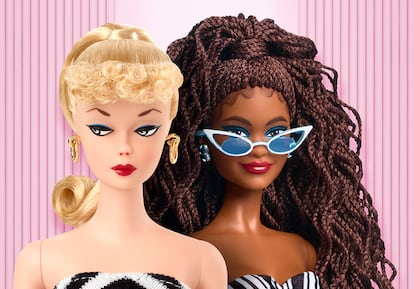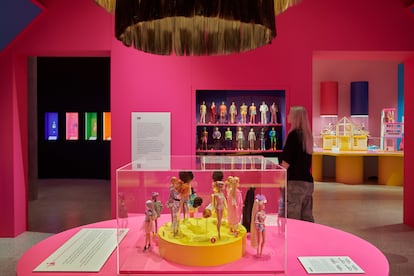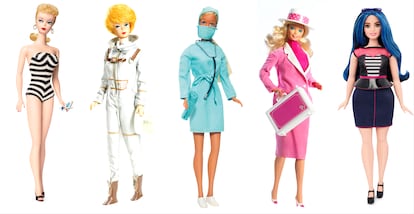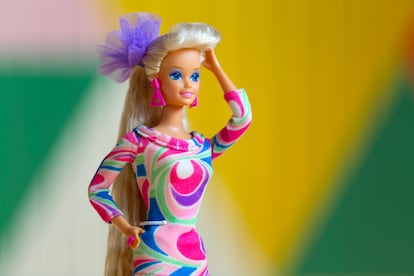Feminist Barbie vs. Reactionary Barbie: Why Mattel’s doll contains many identities
On its 65th anniversary, an exhibition in London questions the liberated reinterpretation offered by Greta Gerwig’s blockbuster film. The story of the successful toy is, in fact, a mix of emancipation and conservatism

Was Barbie as much of a feminist as we thought last year? A year after the release of the movie directed by Greta Gerwig, which became the highest-grossing production in the history of Warner studios and the biggest world premiere of 2023, a new exhibition in London questions the recent reinterpretation of the doll. Launched on the occasion of Barbie’s 65th anniversary, this new exhibition at the Design Museum, which can be visited until February 2025, offers a historical journey through 250 objects and 180 iterations of the doll, revealing a much more ambivalent nature: a mix of liberated but also conservative attributes.
“The relationship between Barbie and feminism is full of nuances,” says the curator of the exhibition, Danielle Thom, in a museum room where there is an abundance of visitors who are dressed in pink. “From the beginning, there were elements of feminism in her story. For example, Barbie always had a career and made it clear, through her houses and her cars, that she was an independent woman. But, on the other hand, Mattel always privileged a certain body image and a certain racial identity above all others.” The exhibition was organized with the collaboration of the manufacturer, which has not prevented the curator from inserting “a critical look” in the exhibition. “Mattel has learned a lot from its past mistakes, which explains where it is today,” says Thom.
The first Barbie had a mean face. The exhibition opens with the original model from 1959, a young woman with a perfidious look who already reflected all the contradictions of the character. Dressed in a zebra-print swimsuit, her silhouette seems impossible, a sexist prototype with exaggerated makeup and a socialite lifestyle. Youthful but mature, with a teenage ponytail and adult breasts, Barbie was an ambiguous figure. Simple and sophisticated, suggestive and demure, she contained a multitude of identities from the start. Even so, it is undeniable that she was designed as an object of desire. She was inspired by the German doll Bild Lilli, with a narrow waist, prominent bust and long legs, designed as a collector’s item for adults and not as a toy for children.

One of the keys to her success — Mattel sold 300,000 dolls in one year; a decade later she was generating $500 million annually — was her styles, which also left no room for doubt. Girls could dress her as a bride, a member of a country club, in an evening dress, or in a nightgown. She had jobs from the beginning, but only as a dancer, a nurse, a stewardess, a cheerleader, or a model. A vinyl record of songs released in the early 1960s, designed so that girls would imagine that this 29-centimeter plastic doll was a real woman, included her in the classic search for Prince Charming. Ken, created in 1961, was presented as “Barbie’s boyfriend,” which does not mean that he was a subordinate or laughable figure, as Gerwig suggested. A simple fiction? Not quite: Mattel’s strategy always consisted of turning her into a role model, an avatar that little girls could project themselves into, imagining themselves as adults. “I’ll make it look like it’s you,” sang a little girl in her first commercial, which aired during the Mickey Mouse Club show. Her mission was to “reassure parents by encouraging girls to adopt good personal care habits.”
Yet Mattel was quick to add layers to the character in response to social change. As the 1960s progressed, Barbie took on other jobs and roles, reflecting women’s changing aspirations in the face of the famous “problem that had no name,” as Betty Friedan would say: the dissatisfaction and discontent that women felt in their role as angels in the home. In 1962, Barbie could buy a house, her first cardboard Dreamhouse, even though, in real life, a woman could not obtain a mortgage without her husband’s permission. In 1965, Astronaut Barbie was launched, four years before a man set foot on the Moon. In 1969, an erotic year, the doll became mobile and able to speak. In 1980, the first Latina and Black Barbies appeared, as reflected in the documentary Black Barbie, produced by Shonda Rhimes, which has just been released on Netflix. In 1992, the first President doll was launched, but also the Totally Hair Barbie, with long hair down to her ankles, the best-selling model in its history. The ambivalence was still there.

The 1980s under Reagan and its “working girls,” a mix of conservatism and hyper-consumerism, were Barbie’s best moment. The worst came in 2016, when sales fell to historic lows (there was a drop of 21% in a single year) and Mattel had to launch a crisis plan, which would lead to the launch of four different silhouettes for the doll, whose campaign was reflected in the excellent documentary Tiny Shoulders. It included an unforgettable scene, in which a little girl participating in a focus group refused to play with a doll “because it was fat” (given her curves, none would be larger than a size 40 in real life). In 2017, a Barbie Builder was created and, a year later, in the wake of MeToo, a feminist militant Barbie was launched, made from recycled plastic.
Since that Copernican turn, Mattel has not stopped working on diversity and inclusion with a relentless determination to connect with the spirit of the times. In 2019, the range was expanded to include 176 dolls with nine body types, 35 skin tones and 94 different hairstyles. Barbies arrived in wheelchairs, with prosthetic limbs and with hearing aids. This week, the brand launched the first blind Barbie and the first Black doll with Down syndrome (the white version was released in 2023). And so, against all odds, the former “decorative” woman was emancipated. Was it out of political conviction or simple capitalist inertia? “Barbie changed because of the power of the dollar,” said Gloria Steinem, who is not usually fooled. “The doll represents a liberal version of feminism, never a radical one,” confirms the curator of the exhibition. “We must look at Barbie’s relevance through a corporate and capitalist lens. Barbie is a product. Her version of feminism is acceptable in a centrist context, compatible with the values of a global corporation,” Thom notes.

The exhibition reflects this on several occasions. The Fashionistas collection, launched in 2009, featured a Barbie available in six types of woman: glam, wild, cutie, sassy, girly and artsy. A relative diversity that was nevertheless restrictive under its supposed range of possibilities, limiting the effects of the supposedly beneficial role-playing game to which Mattel always aspires. Doctor Alan F. Leveton, a specialist in pediatric mental health, expressed his concern about the impact of Barbie on girls and boys as early as 1977. “They are introduced to a precocious and joyless sexuality, to fantasies of seduction and conspicuous consumption,” he wrote in The Threat of Barbie Dolls.
The exhibition avoids mentioning other countercultural uses, such as the famous biopic of Karen Carpenter, who died of complications from anorexia, directed by Todd Haynes in 1987 using various models of the doll. Or the Barbie Liberation Organization, a militant group created in 1993 to denounce Mattel’s gender stereotypes, which interchanged the clothes and behaviour of Barbies and GI Joes in its performances.

Barbie lives in mansions with no kitchen or guest room, with a single bed where, for obvious reasons, sex is not practiced; there is a pregnant Barbie, even if the doll has no genitals. The world of Barbie, bathed in the eternal California sun and inseparable from its colonial or modernist architecture (in the exhibition there are Barbie houses inspired by Richard Neutra or Frank Gehry) reminds us that, beneath the polished surface of American culture, there always sleeps a somewhat murky psyche. Behind the perfect appearance of Barbie and Ken, there is something disturbing.
We go back to the beginning: that first Barbie from 1959 was created by Mattel boss Ruth Handler, the daughter of Jewish immigrants who fled the pogroms in Poland. Suddenly, the blonde sylph in a bathing suit seems an unattainable model for that assimilated young woman, a possible double of the girls who must have tormented her at school, having been a victim of anti-Semitism, according to her own confession, in the Denver of her childhood. Greta Gerwig’s film has given Barbie a new legitimacy, although one based on a fallacy. Or many.
Sign up for our weekly newsletter to get more English-language news coverage from EL PAÍS USA Edition
Tu suscripción se está usando en otro dispositivo
¿Quieres añadir otro usuario a tu suscripción?
Si continúas leyendo en este dispositivo, no se podrá leer en el otro.
FlechaTu suscripción se está usando en otro dispositivo y solo puedes acceder a EL PAÍS desde un dispositivo a la vez.
Si quieres compartir tu cuenta, cambia tu suscripción a la modalidad Premium, así podrás añadir otro usuario. Cada uno accederá con su propia cuenta de email, lo que os permitirá personalizar vuestra experiencia en EL PAÍS.
¿Tienes una suscripción de empresa? Accede aquí para contratar más cuentas.
En el caso de no saber quién está usando tu cuenta, te recomendamos cambiar tu contraseña aquí.
Si decides continuar compartiendo tu cuenta, este mensaje se mostrará en tu dispositivo y en el de la otra persona que está usando tu cuenta de forma indefinida, afectando a tu experiencia de lectura. Puedes consultar aquí los términos y condiciones de la suscripción digital.
More information
Archived In
Últimas noticias
Most viewed
- Sinaloa Cartel war is taking its toll on Los Chapitos
- Oona Chaplin: ‘I told James Cameron that I was living in a treehouse and starting a permaculture project with a friend’
- Reinhard Genzel, Nobel laureate in physics: ‘One-minute videos will never give you the truth’
- Why the price of coffee has skyrocketed: from Brazilian plantations to specialty coffee houses
- Silver prices are going crazy: This is what’s fueling the rally











































